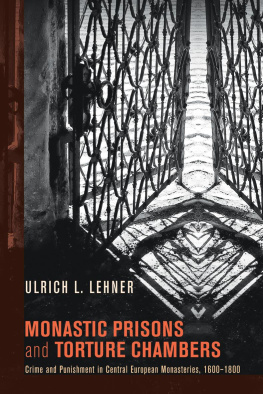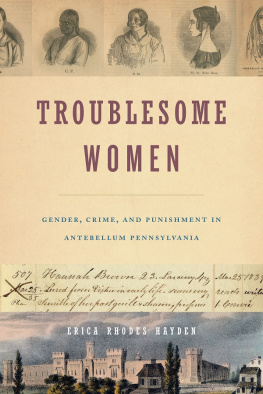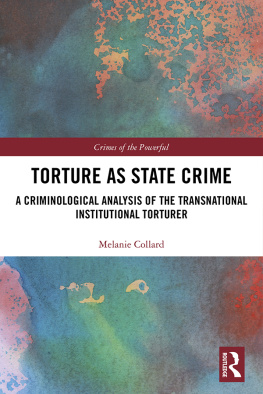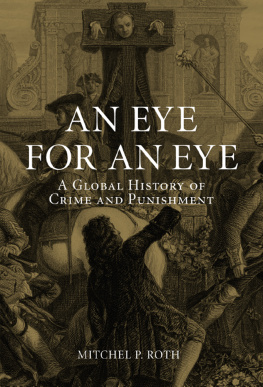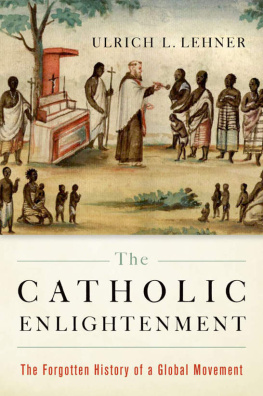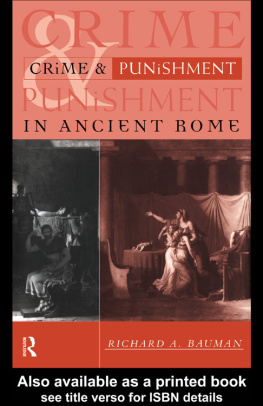Monastic Prisons and Torture Chambers
Crime and Punishment in Central European Monasteries, 16001800
Ulrich L. Lehner
MONASTIC PRISONS AND TORTURE CHAMBERS
Crime and Punishment in Central European Monasteries, 16001800
Copyright 2013 Ulrich L. Lehner. All rights reserved. Except for brief quotations in critical publications or reviews, no part of this book may be reproduced in any manner without prior written permission from the publisher. Write: Permissions, Wipf and Stock Publishers, 199 W. 8th Ave., Suite 3, Eugene, OR 97401.
Cascade Books
An Imprint of Wipf and Stock Publishers
199 W. 8th Ave., Suite 3
Eugene, OR 97401
www.wipfandstock.com
isbn 13: 978-1-62564-040-6
eisbn 13: 978-1-62189-962-4
Cataloguing-in-Publication data:
Lehner, Ulrich L., 1976
Monastic prisons and torture chambers : crime and punishment in central european monasteries, 16001800 / Ulrich L. Lehner.
xii + 106 pp. ; 23 cm. Includes bibliographical references.
isbn 13: 978-1-62564-040-6
1. Monasticism and religious ordersHistoryModern period, 1500. 2. PrisonsHistory. 3. CrimeEurope, CentralHistory. I. Title.
BX2820 .L44 2013
Manufactured in the U.S.A.
Alphonso Hubermagistro quondam meo dilectissimo
Preface
So this is the castle of your ideasnow show me the dungeon.
Robert Gray
T his book was never intended, and the fact that it was written is due to a number of circumstances I should like to explain. When I began research for a new book on monasticism and the Enlightenment in 2008 , I stumbled upon the writings of former monks denouncing inhumane treatment within the cloister and describing gruesome monastic prisons. Since I had never heard of monastic prisons before, I attempted to find out more about these institutions, without much success. Moreover, the literature I found was either apologetic or anticlericala fact that bothered me deeply. Consequently, I started searching through archival material for files that might contain material about monastic criminal trials and prisons, with the intention of publishing a small article about it. Once I began consulting the rules of the different religious orders in order to see how each group treated its prisoners, I realized that the topic warranted a little book. As such, it is by no means an exhaustive history of crime and punishment in early modern monasticism, but rather a guide to completely overlooked fields of researchsuch as criminal law in monastic settings, church and state conflicts regarding criminal lawsuits, violence in monasteries, monastic gender research and monastic mentality, the development of criminal law and criminal investigation, and so forth.
Reconstructing a culture of crime and punishment, of torture and inhumane treatment, was a personal challenge and an unpleasant experience. Nevertheless, as a historian I am convinced that such a reconstruction is necessary for a better understanding of early modern Catholicism, and consequently also early modern culture; and as a theologian I believe that only the truth will set [us] free (John :). Although the following pages might prove embarrassing for a Catholic to read, a thorough analysis of crime in Catholic religious communities should not overshadow the great efforts of the early modern orders in helping the poor, lonely, and marginalized, or their striving for a holy life and a reform of the church.
My colleagues in the Marquette Theology Department encouraged me to pursue the quest for historical truth in moments when I wanted to give it up. I thank in particular Ralph del Colle (), D. Stephen Long, Daniel C. Maguire, and Mickey Mattox for their friendship and reassurance. Furthermore, Chad Pecknold, School of Theology and Religious Studies of the Catholic University of America; Julius Ruff, Marquette University History Department; and Daniel-Odon Hurel, Universit Jean Monnet/Saint-tienne, provided assistance and helpful feedback. I am also indebted to many archives, especially those of the Haus-, Hof- und Staatsarchiv of Vienna and the Diocesan Archive of Trier. While some religious orders were extremely helpful (in particular, the Capuchins in Alttting), others insisted that no files existed about eighteenth-century disciplinary cases or that their orders never had monastic prisonseven if their own constitutions proved otherwise.
One order in particular will be associated with monastic prisons after reading this bookthe Capuchins. I would like to state for the record that I have nothing against this order but only followed the evidence I found in archival and printed sources. In fact, two of my uncles were Capuchins, and while I doubt they would have found this book enjoyable reading, I think they would have wanted it to be published.
I would like to dedicate this book first and foremost to my first teacher of history, Alphons Huber, a role model of academic precision and congeniality, who inspired my interest in paleography and archival studies at the tender age of twelve. Second, I wish to dedicate it to my relatives and friends in religious orders, who have shown me the beauty and candor of a religious vocation.
Milwaukee, Wisconsin
March 2013
. Gray, Lineations , . I thank my friend Kevin Hart (University of Virginia) for bringing this epigram to my attention.
. Lehner, Enlightened Monks.
. See, for example, Chtellier, The Religion of the Poor ; Chtellier, The Europe of the Devout ; Bedouelle, The Reform of Catholicism .
Introduction
Legends, Myths, and Misconceptions
W herever people strive for holiness, there is also sin, as the road to perfection is a long and difficult journey on which not everyone will prevail. It should therefore not surprise us that sinful behavior occurs also in monasteries. Yet, why should historians and scholars of religion care about how monasteries dealt with severe sins or even crimes within their communities?
There are a number of answers to such a legitimate question. First, monastic rules about criminal trials and imprisonment demonstrate the convoluted relationship between canon law and the development of modern judicial practices. Today we take the right to a defense counsel for granted, without realizing that such a practice made its way into modern law through the rules of inquisitorial trials conducted under canon law. Fourth, especially during the eighteenth century, the judicial sovereignty of monasteries was questioned or denied by state authorities. Therefore, monastic criminal trials became during this time a hotbed of state-church conflicts, and our knowledge of these trials contributes to a better understanding of the relationship of church and state during the long eighteenth century. Fifth, monastic criminal law enables historians to reconstruct a forgotten gender perspective and to determine differences between female and male religious in regard to crime and punishment. Last but not least, a treatment of monastic prisons seems necessary due to widespread legends and rumors about them, in particular in anti-Catholic writings. A thorough historical account may help one discern what is legend, myth, misconception, or historical truth.
Another question is why, among historians, monastic prisons remain largely unknown. Despite the fact that even the Carmelite saint and mystic John of the Cross ( 15421591 ) suffered in a monastic dungeon for an entire year ( 157778 ),

